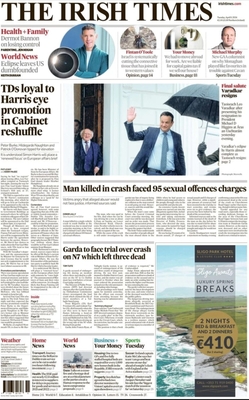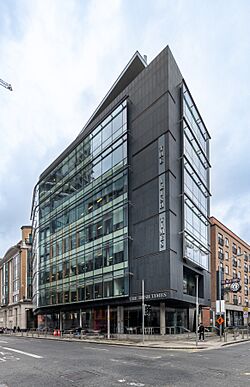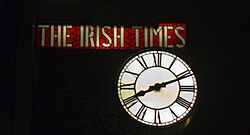The Irish Times facts for kids
 |
|
| Type | Daily newspaper |
|---|---|
| Format | Broadsheet |
| Owner(s) |
|
| Founded | 29 March 1859 |
| Language |
|
| Headquarters | 24–28 Tara Street, Dublin, Ireland |
| Circulation | Circulation no longer audited |
| ISSN | 0791-5144 |
| OCLC number | 137350020 |
The Irish Times is a newspaper from Ireland that comes out every day, except Sundays. You can read it on paper or online. It first started on March 29, 1859. The current editor is Ruadhán Mac Cormaic. The Irish Times is one of Ireland's most important newspapers. It is seen as a "newspaper of record" for Ireland, meaning it keeps a detailed history of events.
When it first began, it supported a certain group of Irish people. However, after about 20 years, it changed its views and started supporting a different idea for Ireland's future. Today, it is known for being open-minded and looking to the future, especially on social topics. On money matters, it's a bit more traditional. For a long time, its editors were from a specific background. But in 1986, after 127 years, it had its first editor from a different Irish background.
Many famous writers and thinkers have written for The Irish Times. These include Fintan O'Toole and Miriam Lord, who writes funny articles. Even a former leader of Ireland, Garret FitzGerald, used to write for the paper. Michael O'Regan was a reporter at the Irish Parliament for over 30 years. Important international leaders like Tony Blair and Bill Clinton have also shared their thoughts in its opinion section.
Some of its most well-known columns include Backbencher, which was about politics. Drapier was a secret column written by a politician, giving an "inside" look at politics. Rite and Reason is a weekly column about religion. And An Irishman's Diary has been running for a very long time. This diary was written by different people over the years, often using the pen name "Quidnunc." Frank McNally usually writes it now. In the sports section, Philip Reid is the newspaper's golf expert.
One of the most popular columns was Cruiskeen Lawn. This was a funny and sharp article written by Myles na gCopaleen, which was the pen name for Brian O'Nolan. He also wrote books as Flann O'Brien. Cruiskeen Lawn means "little full jug" in Irish. It first appeared in 1940 and continued until O'Nolan passed away in 1966.
Contents
- History of The Irish Times
- Newspaper's Views and Important Stories
- How The Irish Times is Run
- Offices of The Irish Times
- Irish Times Literature Prizes
- What You'll Find in The Irish Times
- Editors of The Irish Times
- Writers and Reporters
- How Many People Read It
- Newspapers Owned by The Irish Times DAC
- Other Businesses Owned by The Irish Times DAC
- See also
History of The Irish Times
How it Started in the 1800s
A newspaper called The Irish Times was first created in 1823, but it closed down a few years later. The name was used again many years later by Lawrence E. Knox. He was a 22-year-old army officer. At first, he published the paper three times a week, but soon it became a daily newspaper. The very first daily edition came out on March 29, 1859. Knox wanted it to be a newspaper that supported moderate Protestant views. He called it a "new conservative daily." Its first office was in Dublin.
After Knox passed away in 1873, the newspaper was sold for £35,000. It was bought by the wife of Sir John Arnott. He was a politician and a former Lord Mayor of Cork. He also owned Arnotts, a big department store in Dublin. This sale brought two big changes. The newspaper's office moved to a new street, where it stayed until 2005. Also, its political views changed a lot. It started to strongly support the idea of keeping Ireland connected to the United Kingdom.
The 1900s and Beyond
Even though the newspaper became a public company in 1900, the Arnott family still owned most of it until the 1960s. The last Arnott family member on the newspaper's board passed away in 1958.
From 1934 to 1954, the editor was R. M. Smyllie. The person who was editor for the longest time was Douglas Gageby.
In 1974, the newspaper's ownership was given to a special group called The Irish Times Trust. The previous owner, Major Thomas McDowell, was made "president for life" of this trust.
The Irish Times opened its first office in Asia in 1996. This was when foreign reporter Conor O'Clery moved to Beijing, China.
The 2000s: Changes and Growth
In 2002, The Irish Times faced some money problems. This was because less money came in from advertisements, and the company had spent a lot on a new printing factory. No journalists lost their jobs, but many chose to leave with a special payment. The newspaper changed how it worked. Some of its foreign offices were closed, and it stopped printing special "colour" pages for different Irish regions. Instead, regional news was combined with general news. These changes helped the paper. After losing money in 2002, it started making a profit again in 2003.
In May 2005, the newspaper started a new international edition. This meant it could be bought in London and other parts of England at the same time as other daily newspapers. Before this, copies were flown from Dublin, arriving later in the day.
In 2017, The Irish Times made a deal to buy other newspapers, radio stations, and websites from a company called Landmark Media Investments. This deal was completed in July 2018. In September 2018, The Irish Times offered a plan for some staff to leave voluntarily after this purchase.
Growing in New Ways
The Irish Times company has also started to earn money from other things besides its main newspaper. It bought a big share in a group that publishes local newspapers in West Dublin. It also bought MyHome.ie, which is a popular website for finding properties in Ireland. This was a way to make sure the company had other ways to earn money, especially as traditional newspaper advertising changed.
In 2009, the company announced it had lost money and that 90 staff members would leave. The director who had led the company's new investments later retired.
The managing director said in 2009 that apps for mobile phones would be very important for newspapers. Today, The Irish Times has apps for iPhones and Android phones.
In May 2024, it was announced that The Irish Times Group had bought RIP.ie, a website that shares obituary notices.
Newspaper's Views and Important Stories
The editor in the 1930s, R. M. Smyllie, was strongly against fascism. He upset some religious leaders by not supporting General Franco during the Spanish Civil War. During World War II, The Irish Times had to deal with the Irish Government checking what they printed. The newspaper generally supported the Allies in the war and did not agree with Ireland's policy of staying neutral.
In 1969, the longest-serving editor, Douglas Gageby, faced criticism because of how the newspaper reported on Northern Ireland when the Troubles began. The paper supported Irish nationalism at that time.
In 2003, a columnist named John Waters spoke out about the high salaries of the newspaper's top leaders. He was fired but then hired back a week later. Another columnist, Fintan O'Toole, later said that the high salaries seemed excessive, especially when the paper was also cutting jobs.
On December 23, 2004, The Irish Times printed a front-page story about a large bank robbery. On the same day, they decided not to print a column by Kevin Myers that said a certain group was responsible. Myers was surprised by this decision. He later left the paper in 2006.
The Irish Times generally supported the Lisbon Treaty in 2007, which changed how the European Union worked. However, it also printed articles from people who disagreed with the treaty.
In 2011, the paper published an article by Kate Fitzgerald. The paper did not know that she had passed away before the article was published. This led to a big discussion across Ireland about mental health. The article mentioned her employer, and later, her parents complained about an apology the paper made to that employer. Their complaint was upheld by the Press Ombudsman.
In September 2019, the paper reprinted an article from the New York Times about the health risks of 5G technology. A complaint was made to the Press Council of Ireland, and they ruled that The Irish Times had not been completely accurate in that article.
How The Irish Times is Run
In 1974, the newspaper's ownership was given to a special group called The Irish Times Trust. The former owner, Major Thomas McDowell, was made "president for life" of this trust. He passed away in 2009.
The Trust is guided by legal documents and managed by a group of people called Governors. It is not a charity and cannot give out profits to shareholders. Any money The Irish Times makes must be used to make the newspaper stronger. The Trust can have up to 11 Governors. These Governors are chosen to represent people from all over Ireland.
As of March 2023, John Hegarty is the head of the Trust. The Governors include Edmond Harty, Maeve Carton, Catherine Day, Bernard Harbor, David Sterling, Fiach Mac Conghail, and Marguerite Sayers. Many of them have worked in public service in Ireland.
In 2015, The Irish Times Trust Limited became a member of the European Press Prize.
Offices of The Irish Times
In 1895, the newspaper moved from its first offices to D'Olier Street in the middle of Dublin. Because of this, "D'Olier Street" became a nickname for The Irish Times, which was also sometimes called "The Old Lady of D'Olier Street." In October 2006, the newspaper moved to a new building on Tara Street, which is nearby.
Irish Times Literature Prizes
The Irish Times Literature Prizes were started in 1988. The first big prize, the Irish Times International Fiction Prize, was given out in 1989. There were also Irish Literature Prizes for fiction, poetry, and non-fiction written in English. In 1998, a new prize was added for works written in the Irish language.
The Irish Times International Fiction Prize was given out every year until 2001. Here are some of the winners:
- 1989: Libra, by Don DeLillo
- 1990: Possession, by A. S. Byatt
- 1991: Wartime Lies, by Louis Begley
- 1992: Mating, by Norman Rush
- 1993: The Shipping News, by E. Annie Proulx
- 1995: The Master of Petersburg, by J. M. Coetzee
- 1997: Reading in the Dark, by Seamus Deane
- 1999: Birds of America: Stories, by Lorrie Moore
- 2001: Anil's Ghost, by Michael Ondaatje
What You'll Find in The Irish Times
Regular Columns
Some of the regular columns you can read are:
- An Irish Diary: This is a daily column. It used to be called An Irishman's Diary and was written by "Quidnunc." Sometimes the title changes to match the writer, like An Irishwoman's Diary. Frank McNally has been a frequent writer since the 2000s.
- Another Life: This is a weekly column about nature. Michael Viney has been writing and drawing for it since 1977.
- Rite and Reason: This is a weekly column about religion. Many religious leaders and thinkers have written for it.
- Social and Personal: This column covers social events and personal news.
The Print Newspaper
The newspaper usually has the same layout every day. The front page has one main picture and three main news stories. A column on the left, called News Digest, gives you a quick look at stories inside. These include Irish news, world news, sports, and business. It also has information like lottery numbers and weather.
Inside, you'll find about eight to twelve pages of Irish news, called "Home News." This covers both the Republic of Ireland and Northern Ireland. It also has many pages for important stories like government reports or court cases.
The "World News" section has news from its reporters in other countries and from news services like Reuters. The Irish Times has reporters in London, Paris, Brussels, and Washington.
Every Thursday, The Irish Times publishes a special section about homes for sale. This is one of the main places to find property listings for the Dublin area. You can also find it online. There are also special sections for cars on Wednesdays and jobs on Fridays, which are also online.
A business section comes out every Friday. There's also an entertainment section called The Ticket. It has reviews of movies, music, and theatre, plus interviews and listings.
On Saturdays, there's a "Weekend" section with news features, art stories, and book reviews. The Saturday paper also includes "The Magazine" with articles about food, gardening, and travel. Plus, there are sports sections.
Every day, the paper has three Sudoku puzzles and two crosswords. One is a tricky "cryptic" crossword, and the other is a simpler one. There's also a page where readers can send in letters. J.J. Walsh has been writing a chess puzzle for the paper since 1955.
The newspaper features political cartoons by Martyn Turner. The business section has a funny drawing by David Rooney every Friday. Tom Mathews draws an "Artoon" for the arts section on Saturdays.
On Wednesdays, there is a weekly page written in the Irish language.
Online and Digital
In 1994, The Irish Times started its first website. It was one of the first newspapers in the world to be online. For a while, its online newspaper was published on ireland.com. At first, you could read most of the content for free. But in 2002, they started charging a fee to access most articles.
On June 30, 2008, the company changed ireland.com to be a separate website about lifestyle. The newspaper's online edition then moved to irishtimes.com. News on this new website was free, but you had to pay to look at old articles.
In October 2012, The Irish Times sold the ireland.com website name. The email service connected to ireland.com also ended.
On February 17, 2015, the newspaper announced that it would start charging for access to its website, irishtimes.com, again. This began on February 23.
Editors of The Irish Times
- George Ferdinand Shaw (1859)
- Rev. George Bomford Wheeler (1859–1877)
- James Scott (1877–1899)
- William Algernon Locker (1901–1907)
- John Edward Healy (1907–1934)
- R. M. "Bertie" Smyllie (1934–1954)
- Alec Newman (1954–61)
- Alan Montgomery (1961–1963)
- Douglas Gageby (1963–1974 and 1977–1986)
- Fergus Pyle (1974–1977)
- Conor Brady (1986–2002)
- Geraldine Kennedy (2002–2011)
- Kevin O'Sullivan (2011–2017)
- Paul O'Neill (2017–2022)
- Ruadhán Mac Cormaic (2022–present)
Writers and Reporters
- Charles Acton
- Malachy Clerkin
- Gerry Thornley
- John O Sullivan
- Sean Moran
- Johnny Watterson
- Gavin Cumiskey
- Mary Hannigan
- John Banville
- Brendan Behan
- Maeve Binchy
- Vincent Browne
- Tom Clonan
- Myles na gCopaleen
- Cónal Creedon
- Garret FitzGerald
- Theodora FitzGibbon
- Donal Foley
- Elgy Gillespie
- John Healy
- Mary Holland
- Róisín Ingle
- Dennis Kennedy
- Karlin Lillington
- Liam MacGabhann
- Emer McLysaght
- Lara Marlowe
- Seamus Martin
- Kevin Myers
- Breda O'Brien
- Conor O'Clery
- Aidan O'Sullivan
- Fintan O'Toole
- Fergus Pyle
- Arthur Quinlan
- Martyn Turner
- John Waters
- Noel Whelan
- Terence de Vere White
- Thomas Woods
- Maev-Ann Wren
- Newton Emerson
How Many People Read It
Print Copies
In 2011, about 100,000 copies of the newspaper were printed for each issue. By 2017, this number had dropped to about 62,000. The newspaper's circulation (how many copies are sold) is no longer officially checked.
| Year (period) | Average circulation per issue |
|---|---|
| 2005 (July to December) |
117,370
|
| 2011 (January to June) |
100,951
|
| 2012 (January to June) |
92,565
|
| 2012 (July to December) |
88,356
|
| 2014 (January to June) |
80,332
|
| 2014 (July to December) |
76,882
|
| 2015 (January to June) |
76,194
|
| 2016 (January to June) |
72,011
|
| 2016 (July to December) |
66,251
|
| 2017 (January to June) |
62,423
|
| 2017 (July to December) |
61,049
|
| 2018 (January to June) |
60,352
|
| 2018 (July to December) |
58,131
|
| 2019 (January to June) |
56,518
|
| 2019 (July to December) |
54,147
|
Digital Readers
Digital circulation counts how many people pay for online subscriptions that include an ePaper (an electronic version of the newspaper). This means free student editions and basic packages without an ePaper are not counted in these numbers.
| Year (period) | Average circulation per issue |
|---|---|
| 2017 (July to December) |
16,939
|
| 2018 (January to June) |
18,903
|
| 2018 (July to December) |
21,275
|
| 2019 (July to December) |
24,389
|
Newspapers Owned by The Irish Times DAC
- The Irish Times
- Irish Examiner
- The Echo
- Roscommon Herald
- Western People
- Waterford News & Star
- The Nationalist (Carlow)
- Kildare Nationalist
- Laois Nationalist
Other Businesses Owned by The Irish Times DAC
Magazines
- Gloss Magazine
Radio Stations
- WLR FM
Digital Businesses
- RecruitIreland.com
- BreakingNews.ie
- Myhome.ie
- RIP.ie
Other Assets
- Itronics (a training company)
- DigitalworX (a web publisher)
See also
 In Spanish: The Irish Times para niños
In Spanish: The Irish Times para niños
- List of newspapers in Ireland
- Irish Times National Debating Championship
- List of Irish companies
- The Times (United Kingdom)
- The New York Times (United States)



